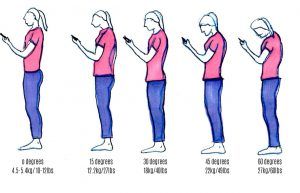Many of us work at a desk or sit for a living. We also live in a very virtual world, using our mobile phones and iPads or tablets to do everything from emails, search the internet and play games. It’s easy to spend hours in front of a screen, and not even notice.
Over time this can lead to a forwards head posture, placing the spine under much more stress that it is designed to withstand on a daily basis.
Combined with stress, poor sleep, driving and poor sleeping and waking posture, it’s no wonder this can all lead to headaches. Other factors can of course include hydration, when you last ate and hormones (again!). These are things to look at in the bigger picture and I highly recommend massage or visiting someone like Jane, who specialises in working with ladies with headaches and ongoing migraines. She can advise treatments such as reflexology and other techniques to help you manage your symptoms.
When the head is placed in a more forwards position, it actually causes an imbalance in the muscles of the neck, shoulders, upper/mid back and chest area. This means some muscles are held in a shortened position and others are held in a lengthened position, neither ideal if you hold that position all day. The extra tension that is being placed in these muscles can then lead to headaches as most of them have connections to the neck and skull. The forwards position is also likely to have an affect on your breathing, which can then alter your CO2 and Oxygen levels, and make your breathing more shallow. This altered breathing usually leads to the neck, upper back, chest and shoulder muscles working overtime to help get air into your lungs.
 So what if you can’t get a good old massage right now or attend a Pilates class?
So what if you can’t get a good old massage right now or attend a Pilates class?
Start thinking about your posture! Now that doesn’t mean sitting bolt upright and rigid through the spine, in fact the old “motion is lotion” saying is more appropriate!
But here is a few things you can do:
- Roll your shoulders often
- Move your head! Side to side, ear to shoulder, look at your armpit. Try not to use the hand on the head, make it a more fluid gentle stretch.
- Put your hands behind your back.
- Open your chest, think wide across the front of the chest or lifting the breast bone up.
- BREATHE! Think deep into the pelvis and wide into the ribs and the back of the spine.
- Hold your device up! Make sure the screen is lifted to your eye-line, try not to drop your head to look at it!

